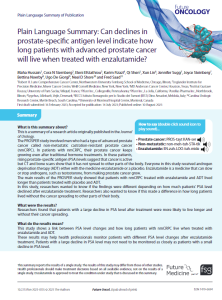A plain language summary looking at whether declines in prostate-specific antigen level indicates how long patients with advanced prostate cancer will live when treated with enzalutamide
 This Plain Language Summary of Publication article published in Future Oncology looks at prostate-specific antigen (PSA) levels. This summary describes a study that involved men who had a type of advanced prostate cancer called non-metastatic castration-resistant prostate cancer (nmCRPC). In these participants, rising PSA levels suggest that the cancer is active but scans show that it has not spread to other parts of the body. Researchers found that participants with a large decline in PSA level after treatment with the medication enzalutamide were more likely to live longer without their cancer spreading.
This Plain Language Summary of Publication article published in Future Oncology looks at prostate-specific antigen (PSA) levels. This summary describes a study that involved men who had a type of advanced prostate cancer called non-metastatic castration-resistant prostate cancer (nmCRPC). In these participants, rising PSA levels suggest that the cancer is active but scans show that it has not spread to other parts of the body. Researchers found that participants with a large decline in PSA level after treatment with the medication enzalutamide were more likely to live longer without their cancer spreading.
Read the article here.
The original article on which this summary is based is called ‘Nadir Prostate-specific Antigen as an Independent Predictor of Survival Outcomes: A Post Hoc Analysis of the PROSPER Randomized Clinical Trial’. It was published in The Journal of Urology.
Read the original article here.
